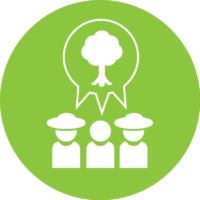How Public-private Partnerships can Empower Communities and Improve Restoration Outcomes
Cagalanan, Dominique. 2016. Public-private partnerships for improved reforestation outcomes in the Philippines. World Development Perspectives 3: 32-34. https://doi.org/10.1016/j.wdp.2016.11.004.
(http://www.sciencedirect.com/science/article/pii/S2452292916301369)
Historically, most upland areas of the Philippines were covered in rain and cloud forest. But today, visitors to a typical upland landscape are likely to find patches of grass and shrub, some new forest growth that is unlikely to grow to mature forest because it is at risk of being cleared for agriculture, with areas of old growth forest only in the most remote and inaccessible areas. Populating these landscapes are communities of poor farmers who have small family farms used for mostly their own consumption or small-scale market production.
This case from the Philippines highlights how public-private partnerships can help organize, train, and empower communities to achieve better reforestation outcomes. Forests are important for biodiversity and ecosystem services and for the livelihoods of forest-dependent people around the world. These are all at risk in the Philippines, a country with a long history of deforestation.
Reforestation efforts have been made in the Philippines for more than a century but have not had major success. Recent community-based projects have had limited long-term success, partly because communities are treated as the paid labor to plant the trees but are not thoroughly trained and empowered to manage reforestation sites on their own. Today, there are several reforestation programs with many people involved, including the government, private companies, non-profit organizations, and communities. This research looks at one well-known community organization and their experiences with reforestation to see what works, what does not, and how partnerships between stakeholders might help improve outcomes. From this case, we can learn how to improve reforestation in the Philippines and other parts of the world where there are multiple people working on reforestation.
The community in this research was part of a national government reforestation program, which is similar to old programs and so could repeat past failures. The community was also part of another reforestation program of a private geothermal company. The geothermal company helped increase the amount of community organizing and training for seedling production, reforestation site management, and forest protection beyond what the national government was able to do alone. This case illustrates how coordinating with multiple stakeholders, such as through the public-private partnership examined here, national reforestation efforts can help upland communities receive better training and support, and ultimately improve reforestation outcomes for any programs in which they are involved.
This case report was part of a special issue of World Development Perspectives, guest edited by Sarah Wilson and Dominique Cagalanan, compiled by the governance working group at the second PARTNERS workshop, led by Ashwini Chhatre.
The PARTNERS connection
David Bray was an active member of the PARTNERS steering committee. He participated in this special issue in World Development Perspectives led by Dr. Ashwini Chhatre (editor) and Dr. Sarah Wilson and Dominique Calaganan dedicated to forest restoration.


